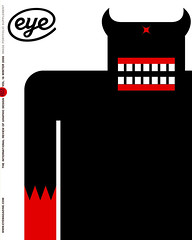Winter 2006
Design is not a solution
A piece of design is the expression of an idea. It’s not a solution
Mark Thomson’s talk ‘Design is not a solution’ was given at Eye Forum no. 1, ‘Burning Issues’, that took place at the RSA in London, 23 November 2006.
There is a point of view in the design world that says that ‘design’s purpose is to solve problems’, and that design is expressed in ‘solutions’. It always makes me think of Marcel Duchamp’s comment: ‘There is no solution because there is no problem’. It makes me think: what happens if there’s no problem in the beginning? Would there be no design?
Duchamp was talking about a door in his apartment that could be both open and closed at the same time, but the comment could also be interpreted in a wider way, as his approach to work and life. And the same idea comes into my mind when I hear that design is a solution: why problematise the world? Do I have to have problems to be a designer?
I don’t know where this point of view of design came from. I can’t imagine the works of Theo van Doesburg or Max Bill, or Eric Gill, Jan van Krimpen or Giovanni Mardersteig being described as a ‘solution’, or any of those designers chewing on a pencil while formulating the next problem to be solved.
It’s not that problems and solutions never come up. Sometimes there are genuine problems than can be ‘solved’ in the same way as a mathematical problem – some pieces of information design, for example. And there’s also an element of resolution in a lot of design. Ideas are developed to a point at which they are thought to be ‘resolved’, like the resolution of a theme in a piece of music.
‘Design’s purpose is to solve problems’ is obviously an answer to the question: ‘What is design for?’. I don’t know that it helps to ask this question at all. I used to pass a sign on the way to work that said: ‘God is the answer – now what’s the problem?’ Is design really an idea in search of a purpose?
And what about when the ‘solution’ is itself a problem? Who really needed the plastic cup? Another 4x4? What exactly is the problem there?
Another example: the US presidential election in 2000 turned on the design of the so-called ‘butterfly ballot’ paper. This ballot paper had been designed to make it easy to count votes by machine. Voters would punch a hole alongside their chosen candidate, and the choice would be picked up by an infra-red beam. But the paper itself was so visually confused that many people actually voted against their candidate by mistake. By any standards it was a bad solution.
There is of course work that was not designed to solve anything: ‘no problem’ work. One of my favourites is the Paris street sweeper’s broom with its perfectly copied twigs in fluorescent green plastic. There’s no reason for these ‘twigs’ to be such perfect simulations, other than to surprise and be funny.
And then there is work that was not ‘designed’ at all – the undesigned world. Are letters scratched in the dirt with a stick less capable of holding thought than those drawn in Bézier curves at 2000 per cent? The undesigned world is neither more nor less imperfect than the designed world.
‘Design’s purpose is to solve problems’ is a big statement, and actually I would rather avoid simply replacing it with another big statement. I am uncomfortable with making ‘design is…’ statements. I want to shake off those ideas that reduce design to cause and effect, or anything else. I want to reject formulas, because formulas only produce formulations. And I want to lose the ‘big idea’ idea and replace it with nothing at all – to allow something else to develop in its place.
It’s an existential view. I think design existed before the twentieth century; it just had a different name. It’s what Francesco Griffo was doing, and Claude Garamond. It’s what scribes did.
I prefer just to think of design as expression of ideas, and as language. It’s a way of experiencing the world. What I’m interested in is the idea of pleasure, desire, uselessness – of walking through the world with your eyes open. Not cause and effect, but sensation.
This is both an approach to doing work and a way of experiencing the world, designed and undesigned. It’s a liberating approach, because it removes the need to be ‘right’. It’s about looking at design in a democratic way: as something we share rather than something a few people do. A piece of design is the expression of an idea. It’s not a solution.
Eye Forum no. 1, ‘Burning Issues’, RSA, London, 23.11.06
Mark Thomson, designer, typographer, London
First published online to coincide with Eye no. 62 vol. 16 2006
Eye is the world’s most beautiful and collectable graphic design journal, published quarterly for professional designers, students and anyone interested in critical, informed writing about graphic design and visual culture. It is available from all good design bookshops and online at the Eye shop, where you can buy subscriptions and single issues.

